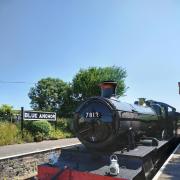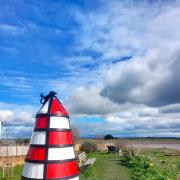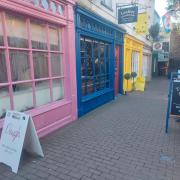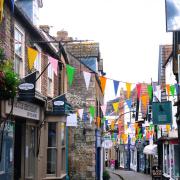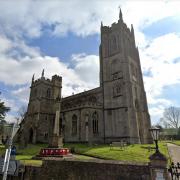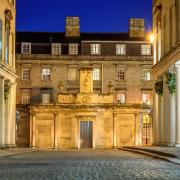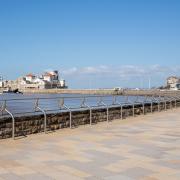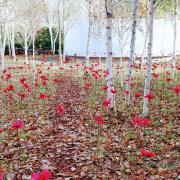The study of Exmoor’s place names is fascinating, providing an intriguing glimpse of life in the past, says GARRY D REED.

Unravelling place names reveals a time when people were much closer to their rural roots, when place names had real significance. Hard evidence for their origin is hard to obtain but research into ancient documents, such as the Domesday Book and Bede’s Chronicle, helps our understanding.
The majority of Exmoor’s place names were composed by the Angles and Saxons. The Celts (C), who established most of the settlements before the Romans invaded, are now mainly represented through river names. Their villages were usually occupied by the Saxon invaders and given new titles, although a few coastal settlements have retained their Celtic names.
Although the Romans ruled Britain for nearly 400 years they largely ignored Exmoor except for fortlets on the Devon side of the moor, and, like the Vikings, had little impact on local place names. Norman influence is limited to the names of land owners.
Old English (OE), the tongue of the Anglo-Saxons up until about 1150 AD, was the forerunner of today’s English. Our language retains a multitude of Saxon words, which have hardly altered over the centuries; ford, land, sand, east, north and west, for instance, still retain their original meaning. Many OE words have only slightly changed.

Common elements of Anglo-Saxon place-names include ham (village or hamlet), borough and burh (fortified place or tumulus), stoke (outlying farm or village), worth and worthy (an enclosure) and stow (a holy place). Place names including ‘ing’ describe ‘people of the place’.
Over the centuries some words have changed their meaning. Field, for instance, now refers to an enclosed piece of land whereas for the Saxons it was open countryside. Exmoor is often referred to as a forest, but medieval royal forests did not necessarily imply woodland. To the Normans forest was a place to raise deer, which needed a variety of land to feed on. To them a forest was unenclosed countryside of heathland, woodland and farm land.
Rivers and springs are common amongst Exmoor place names
Early settlements had to be located by a reliable water source, for drinking, washing, irrigating crops and watering animals. Larger rivers, like the Exe, were also arteries of transport when the land was largely covered in impenetrable woodland.
The Celts named most of Exmoor’s rivers. They named the Winn Brook, near Winsford, the ‘white water’ from the Celtic ‘ean’ (which morphed into ‘win’). The River Quarme was the warm stream and the Haddeo ‘the heather river’ from hoeth (heather).
Exmoor itself takes its name from the River Exe. The Celtic word Exe means ‘water’ or literally, ‘abounding in fish’. Mor is OE for marsh or barren upland. The villages of Exbridge and Exford span and ford the moor’s greatest watercourse, the Exe, which flows south 100km to the English Channel.
There are many ford villages on the moor. Washford drives from waesce (OE), a place for washing. Shillingford is the ford on Sciella’s land and ‘ing’ indicates the people of the settlement. Brushford means the bridge ford.
Dulverton, the home of the National Park Authority, is the ‘hidden ford’ town. It was Dieglaford-tun in 1084, becoming Dolvertune in the Domesday Book. Tolland refers to land by the River Tone, ‘the roaring one’ (C), which also gave its name to Taunton. Williton is the town on the River Willett.
Legend has it that two millennia ago Simon, a Celtic robber, terrorised the inhabitants of Exmoor. In desperation a Cornish holy man was sent for, who converted and baptised him in the River Barle. Simonsbath was the resulting place name - or so the fable goes. In reality the prefix, Simon, could be a chieftain’s name, although ‘simon’ is often connected with boundary lines in the south-west. The bath element is easier to understand as ‘barle’ and ‘batha’ signify water or a pool. The city of Bath is named after the water there. In the same way, Morebath refers to a bathing place; known as Morbatha in the Domesday Book.
At the heart of RD Blackmore’s Lorna Doone country is Oare which took its name from Oare Water, which simply means ‘river’ (C). Monksilver (Sulfhere in 897 AD) derives from munuc (monks) and scir (silver) – ‘the bright and gleaming river’. Ludslade, near Exford, is the ‘valley of the torrent’ and Tarr Steps comes from tochar (C) meaning ‘causeway’. The 17-span clapper bridge, constructed from stone slabs and boulders, is the longest of its kind in Britain.
Many Exmoor place names refer to the environment
Allerford, famous for its packhorse bridge, is a place where alders grow. The OE ‘alor’ refers to the alder tree; it was Alresford in the Domesday Book. Bicknoller also takes its name from alor. Bick probably comes from the Byken or Bickn family.
Land with ash trees, owned by Bretel de St Claire in 1086, account for Ashbittle, similar to Ashway and Ashwick, near Dulverton; wic meaning a farm. Clatworthy probably means a burdock enclosure; clate (OE) refers to burdock and goose-grass while worthy is an enclosure. Hazelgrove and Halscombe relate to local hazel trees.
Nettlecombe and Timbercombe haven’t changed significantly from Saxon times. The first means nettle valley, derived from netel (the plant) followed by cumb, a valley. The second simply means timber valley.
Watchet, with its flourishing harbour, was also once surrounded by timber. Unusually it retains its Celtic name from gwas (under) and coed (wood) meaning ‘under the wood’; the Saxon pronounced it Waeced.
Selworthy was Seleuurde, in the Domesday Book, an enclosure by a willow copse; willow was sele to the Saxons. The village is today famous for its thatched cottages.
Over the generations ‘gyrd’, meaning ‘to fasten’ (related to girdle), has evolved into Yarde, ‘the place where rods or spars are obtained’. Wheddon Cross is the place in the ‘valley where wheat (hwaet OE) grows’.
Withiel Florey is the ‘willow-tree clearing’. Witig is OE for a willow-tree, a withy; leah being a forest glade. In 1237 Randulfus de Flury was the Norman landowner, hence his suffix. Withypool also derived from witig meaning ‘the willow-tree pool’.
Location and topography are described in numerous place names.
In OE clif refers to a steep hill-slope or river-bank. Old Cleeve therefore means old cliff and Birch Cleeve, near Simonsbath, is the escarpment with birch woodland.
Carr is Old Norse for a rock. Carhampton therefore has a partly Viking origin: settlement amongst the rocks. Cloutsham, north of Dunkery Beacon, probably means the village (ham) in the valley (cloh). Upton is, as its name suggests, a ‘high settlement or farm’.
Exmoor’s coastal resort of Minehead is one of the few local place names of Celtic origin. Myne (C) means a mountain or headland to which the OE heafod (headland) has been added. In 1046 it was Mynheafdon and four decades later Mancheve (DB). One of the world’s greatest Science Fiction writers, Arthur C Clarke, was born in the town in 1917 overlooking the beautiful Blenheim Gardens.
Some names relate to farming or man-made features.
Liscombe, close to Tarr Steps, is the ‘valley of the pigsties’. Hiose, which evolved into ‘lis’, was the Saxon name for pig. Porlock, with its charming thatched cottages, probably stems from the Celtic port (harbour) and OE loca (enclosure).
At 519 metres, Exmoor’s highest point, Dunkery Beacon, was originally Duncrey; later Dunnecray. The name probably came from the Celtic ‘din’ or ‘dun’ (hillfort) and ‘creic’ or ‘creag’ (rock). There are several Bronze Age burial mounds around the hill’s summit.
Place names on Exmoor with religious significance are rare. There are no settlements with stow (holy place) on the Somerset part of Exmoor. However, St. Decumans is named after a fifth century Celtic missionary who died as a hermit in Dunster.
Culbone appears in the Domesday Book as Kytenore and also Chetnore. It may originate from the Celtic cil beun meaning ‘Church of St Beuno’, although most consider ‘kites’ ridge’ (from OE cytan ora) more likely.
In Anglo Saxon times villages were occasionally referred to by the name of the thane or tribal leader. After the Norman Conquest this became more prevalent.
Winsford originally meant Wine’s ford, Wine being the landowner’s name. The 4th or 5th century pagan inhabitants of the village probably erected the nearby Caratacus Stone.
Wootton Courtney is the ‘wood (wuda) by the farm’, owned by John de Curtenay in 1274. Ton refers to a village or farm. Bossington means the people (ing) of Bosa’s village.
Combe is a common place name element in Somerset and Devon, from the OE cumb, (valley) and Celtic ‘cumm’ or ‘cwm’. Combe Sydenham was the home of the Sydenham family from the 15th century. Luccombe probably describes the valley of a Saxon landowner although, as lufa means love, ‘love valley’ could conceivably be the true meaning.
The Saxon term for cottage, cot and cote, are common in many other parts of England but less frequent on Exmoor. Holnicote, pronounced ‘Hunnicutt’, was held by the de Holne family in the 13th century. Golonscott may refer to the original inhabitants of the dwelling and Cottiford refers to ‘cottages next the ford’.
Exmoor’s place names are intimately linked with the area’s history, taking us back hundreds, often thousands of years, providing an insight into life when people were closer to their rural roots, carving out their lives and settlements on isolated hills, coast and valleys.




